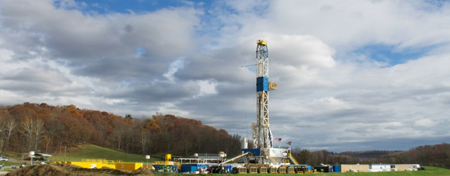Growth in the Utica Shale Looks Promising
Friday, January 31, 2014

NEW PHILADELPHIA, Ohio — The Utica shale is no longer a secret and the future is bright for the oil and gas industry through 2020.
Officials, citizens, researchers and business owners from over 30 counties in Ohio and across five states gathered at the Tuscarawas campus of Kent State University to learn what the Utica shale will look like in 2020.
Technology
Dr. Robert Chase, a professor in the petroleum engineering program at Marietta College, said the one that is needed to develop the Utica in 2020 and beyond is more technology.
He said the one thing that will be most important is understanding the resource.
“Ohio will become an energy exporter and enjoy a period of unparalleled growth,” said Chase.
Laterals
One thing that he thinks will improve by 2020 is a greater understanding o the optimum spacing and the length of laterals. He said it will take more experimentation and simulation before producers can figure out what those exact lengths will be.
Chase said the standard for laterals will be between 5-7,000 feet by 2020.
He also expects more advances in the drilling technology by 2020.
Drilling rigs
Chase said rigs will become more compact and robotic. He expects there will be fewer personnel required on the drilling rig floor by then.
Another area Chase expects to change is more automated well control. He expects that will result in fewer well control problems. He said the computer will be able to sense the problem and shut everything down before a human would be able to if they were in control.
Chase expects the time spent drilling will be reduced by 2020 as well as the drilling costs.
Well pads
One thing that is happening right now that Chase expects will only grow by 2020 is the number of wells per pad. He said he feels there will be more wells drilled per pad with the potential for multiple laterals from the same vertical wellbore.
He gave the example of a well in Monroe County that was drilled by Magnum Hunter which includes Marcellus and Utica shale wells.
Anther difference Chase expects to see is a decrease in well spacing and longer laterals. He expects 750-1,000 wells to be drilled per year by 2020.
Hydraulic fracturing
Other changes Chase expects to see by 2020 is advancements in hydraulic fracturing. He said green frack fluids will become the standard by 2020. In addition, all spent frack fluids will be recycled.
Another difference will be that frack treatments will involve more stages along the laterals.
He said that tests are finding that wells who undergo more stages have better results.
Chase went on to say it takes between 4-5 million gallons of water to frack each well. He expects that increase between 6-7 million galls of water as the number of frack stages increase.
Midstream
Scott Hallam, Access Midstream Partners, said there are lots of good signs about what the Utica shale means to Ohio.
His company puts in compressor stations, processing stations, fractionating sites and pipelines.
Hallam said his company will have 305 miles of pipeline in the Utica.
Although the natural gas liquids (NGLs) being produced in the Utica shale, is a benefit to producers. There is a downside.
“It is a blessing for NGL’s but wreaks havoc on pipeline systems,” said Hallam.
He added that the company must continuously clean the pipelines because the NGLs pile up in the pipes because of the constant changing pressures and temperatures in the pipes. cleaning of the pipelines has to take place bc of NGL’s mainly due to changing pressures.
Regulations
Sean Logan, president of Sean Logan and Associates, said the regulatory climate has already underwent major changes since 2010 and he expects those changes to continue.
“Ohio Oil and gas program is constantly improving and that’s a good thing,” said Logan.
Some of the regulations to change will include a uniform way for well pads to be constructed.
This law change will include having an engineer design the site.
Other regulation changes will impact impoundments on site for fresh water and waste water.
Drillers will also be required to have an electronic record of how fracking waste is handled.




